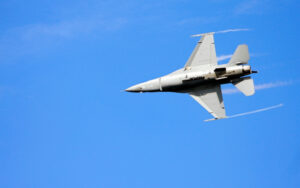New innovations in the military arms race have often had one key defining theme: maximizing the effectiveness of troops and their hardware while minimizing how many are put in harm’s way. Over the last few decades, this has been exemplified by the development of cutting-edge unmanned aerial hardware, such as the General Atomics MQ-9 Reaper drone, which can target adversaries from a control room thousands of miles away.
Russia’s aggression in Ukraine underscores the importance of drone warfare, but also shows a new side to this evolution. Ukraine forces have put low-tech, affordable and sometimes even homemade drones into operation to great effect. However, they are finding that connectivity is a serious issue.
They must either defeat Russian signal jamming, which is knocking out 90% of drones put into the air, or Ukraine must fly so many drones that it simply becomes a numbers game. If the latter choice is taken, then Ukraine forces will have difficulty ensuring that reconnaissance data is sent back securely – particularly if the unit itself isn’t likely to make it home.
Signal and connectivity are now the weakest points of unmanned vehicle warfare – with aerial drones demonstrating the point. To continue developing effective military hardware that keeps human lives out of harms’ reach while staying up to date with international rivals, military forces must focus on connectivity.
At least part of the answer rests in what is known as V-Band IEEE 5G mmWave tactical connectivity, which offers inherent low probability of interception and low probability of detection.
V-band is unique because it causes radio signals to resonate with oxygen molecules in the air– a phenomenon called oxygen absorption. The size of the oxygen molecule almost perfectly resonates with radio frequency signals attenuation, which creates a curtain of invisibility between a tactical team and its adversary. Within the V-band, connectivity truly has a quality of low probability of detection.
These systems can be easily interfaced with existing equipment to ensure modular capability, and they are resistant to a single point of failure.
The data war heats up
The Vietnam War may have been the first televised conflict, but Russia’s invasion of Ukraine is the first war to make use of and rely on a vast quantity of data. Whether that’s from open-source volunteers who spot oddities on Google maps, battlefield communications provided by Starlink satellite services, a location spotted from a troop’s social media video upload or the use of light reconnaissance drones en-masse, the backbone of Ukraine’s valiant defense has relied on data.
Future wars will not deviate from this trend; data security, transmission and access, i.e., “the Digital Battlefield,” will only become ever more central.
The highest-tech drones such as the Reaper cost around $50,000 per hour to fly. Low-tech, smaller drones when used just for reconnaissance purposes cost very little – while still being of great use, particularly to smaller armies on the defense or guerrilla forces, for example. Arms manufacturers have seen the gap between these two and are now racing to develop something effective yet affordable. Iran and Turkey are leading this mid-budget effort.
Lower cost units, particularly the cheapest homemade ones, make the survivability of each unit less of a concern – hence the term “kamikaze drones.” Although this may solve many headaches for the finances behind a military action, it adds another for the intelligence teams who turn data into vital, practical intelligence.
mmWave is a low-detection solution
Traditional unlicensed band Wi-Fi, which some of the smallest and cheapest drones rely on, is no surefire solution. It may be able to hide in plain sight due to the sheer number of devices connected, but the signal is omnidirectional, short-range and easily interfered with and detected. This makes it a risk in the battlefield environment. The consumer standard (3GPP) cellular network encounters similar interference and detection issues but commands longer range than beyond line of sight due to its use of tall cellular towers and lower frequencies.
The IEEE 5G unlicensed 60 GHz solution can be used for line-of-sight data links that are short-range and up to 3.5 Gbps and over 1 Gbps at 1 km distance. Its low probability of detection ensures stealthy scouting operation of these drones even into enemy territory. Beyond line-of-sight signals can be relayed by several relay drones. A prototype of this has been demonstrated by Fujikura Japanese partner Seven to Five Co., Ltd.
Several military trials and developmental activities are on-going in the U.S. and NATO countries for testing IEEE 5G networking solutions. The strong potential for the U.S. and its allies is for making possible high-speed tactical communications at range, simultaneously reducing latency and increasing data processing performance, even in the most volatile environments.
Unmanned devices have developed at lighting speed. So too has wireless connectivity, at least when it comes to speed and performance. The challenge for the industry now is to make connectivity systems modular, reliable and as immune to detection as possible. mmWave technology with its low detection capabilities is the key to both force protection and stealthy connectivity of manned and unmanned battle systems.







